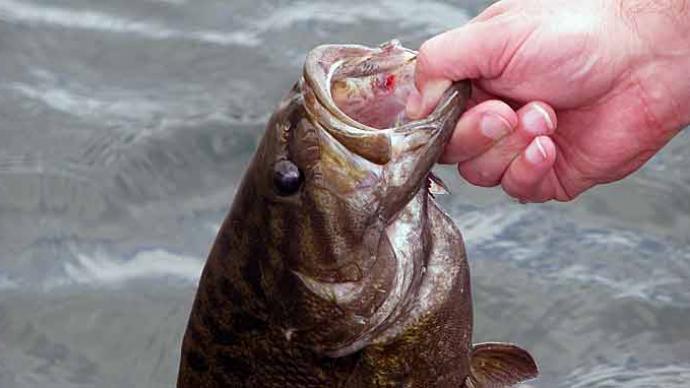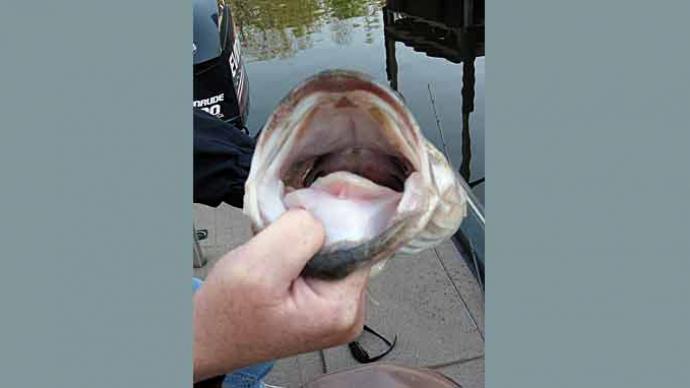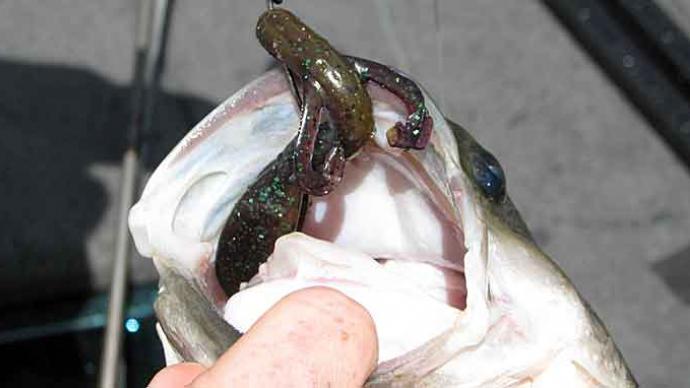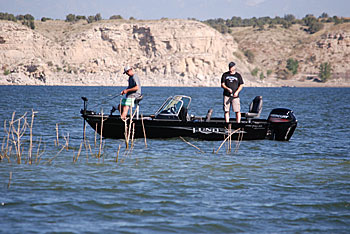
Bass anglers in many parts of the country must learn to deal with wind as part of the equation or not fish. It’s that simple. Some places are just windier than others, and if you’re located in one of those regions, you need to find ways to catch fish still when the wind is blowing.
Wind can beat you mentally. You're already beat if you can hear the wind howling, affecting where and how you plan to fish. You need to have the attitude that wind determines where you want to fish instead of where you can fish. Heading to the back of a cove to get out of the wind to fish is not productive – especially if there are no fish.
Simply put, use the wind to your advantage.
“Wind is my friend,” joked pro bass angler Sam Heckman. Heckman is aware of the wind, its direction, velocity, and how it can positively impact his fishing. Heckman fished a wind-swept point on Oklahoma’s Grand Lake during the Bass Federation Championship in 2015 that others avoided for three straight days and was one fish from winning the whole shebang and garnering a second-place finish. Heckman used the wind and similar tactics to place tenth in this year’s TBF championship on Missouri’s Table Rock Reservoir.
“Wind kind of jumpstarts the whole food chain,” Heckman said. “When winds start blowing into a bank, it pushes the plankton and other microorganisms suspended in the water column against the bank. Minnows, crustaceans, panfish, and other forage move into the shallows or come out of hiding to take advantage of the bounty. Predators are not far behind.”
I joined Heckman last fall on Colorado’s Pueblo Reservoir. Pueblo Reservoir was the only Colorado reservoir in the BASS Top 100 in 2015. The reservoir is renowned for producing impressive numbers of smallmouths, largemouths, spotted bass, and the occasional trophy fish.
The wind was not a factor in the morning. The water was glassed over, and there was a noticeable chill in the September air. The scenario presented perfect conditions for throwing topwater baits. Pueblo Reservoir water levels were up, and the high water had flooded the shoreline brush that had grown during the recent drought setting the stage for some dramatic topwater action.
Heckman maneuvered the boat using the bow-mounted trolling motor to position us to work the indentions and points in the brush. The bass were waiting. Bass routinely exploded on our topwater offerings, but hookups were few. The water temperatures had dropped several degrees overnight and dampened the bass’ metabolism. We could have switched to jigs and caught some of those fish, but we had too much fun watching the bass explode on our topwater baits. We could feel the sun on the back of our necks, and the morning chill was weakening. Soon a few of the bass started to stay buttoned up.
With the rising sun and the morning chill dissipating, we started to feel the wind, light at first, but in a matter of half an hour, there was a pretty good chop in the sheltered coves we fished. “Come on,” Heckman said as he pulled up the trolling motor. “I know where to go.”
There were two- to three-foot whitecaps on the main lake as we made our way to an exposed point that extended into the reservoir. The point, which had been above the water line for several years, was submerged under two feet of water now, and you could easily see where the light sandy point dropped abruptly off into deeper water. The increasing southwest wind was crashing into the point. “Cast right up into the trees on the edge of the drop-off there and let the bait fall,” Heckman instructed.
The tube-rigged crawfish imitation cast like a bullet, and we could easily reach the drop-off 30 yards distant as the trolling motor kept the boat in position. My first cast landed right next to a protruding treetop. as I let it sink, I felt a subtle “tick.” Rearing back on the rod, I announced, “Fish!” I looked over to see Sam’s rod bent double, too.
And so it went. Sam shuttled us up and down the point as we cast to the wind-swept edge of the drop-off. I could count on one hand the number of times I made a cast and didn’t get a strike or catch a fish. At one point, I made three consecutive casts to a prominent stump and caught a largemouth, a smallmouth, and a spotted bass.
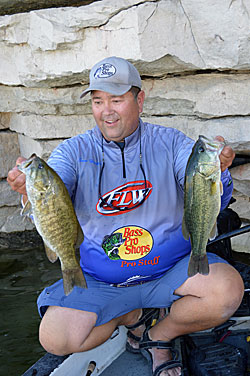
We moved to several other main lake points and had similar results. In a few hours, we caught over 50 bass by playing and utilizing the wind to our favor.
Wind does several things. It stirs the water up, making it murky. Predators feel more comfortable hunting in the stained water. At times, the murky water is only on the surface. “A lot of times, you have a murky layer of water where the waves crash the shoreline and then rolls back out, but underneath, the water is still clear,” Heckman said. “That’s where the predators will be waiting. They can be much shallower than you would think.”
Wave action will bring crawfish out of the rocks to feed, but it can also displace them. “I’ve walked shorelines when the wind was blowing and found hundreds of young-of-the-year crawfish that had been washed up on shore. The same thing can happen to baitfish.” It creates a predator’s nirvana.
Determining the bait de jour is priority number one. “You can cast spinnerbaits if you think the bass are keying on baitfish or use a tube or jig to imitate crawfish,” suggested Heckman. “The fish will tell you what they’re feeding on.”
Bass Pro Joe Balog prefers shallow-running crankbaits in the wind. “You can cast a long way using crankbaits, and crankbaits can imitate everything from crawdads to minnows to panfish.”
“This shallow-water wind-induced bite can happen any time of the day or any time of the year,” shared Heckman. “It happens almost all year long. Dirty water absorbs more sunshine and heat, so it can be a great place to look if the water is still cold.
Keeping the boat in position is critical to success on windy days. And the wind has a dramatic effect on boat control.
“I was one of the first to use a long-shaft trolling motor,” Balog said. “A lot of fishing is about momentum, and you can’t put together a pattern if your trolling motor is constantly coming out of the water.” Balog uses his 36-volt Minn Kota trolling motor to hold in place while working shallow, wind-swept points and slowing or maintaining his speed on productive drifts.
“I’ve busted up my fair share of trolling motors fishing shallow water in the wind,” Heckman admitted. “The results were worth it.”
How you’re dressed can be influential on how you deal with wind. A beautiful sunny day can quickly get windy and nasty. You are either prepared to deal with it, or you go home. A formidable rain suit and a quality lifejacket are mandatory equipment when fishing in the wind. I have a stocking cap and a pair of gloves in the pocket of my rain suit regardless of the season.
Fishing in the wind can be fabulous, but there’s also a certain element of risk. Think like a Boy Scout, and be prepared before heading out the door. Staying safe and warm while fishing on windy days is key to an enjoyable, hopefully productive, day on the water.


